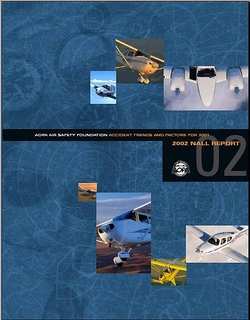ASF Says It's the Lowest Total Since 1938
 The just-released 2002 AOPA Air Safety Foundation
Nall Report shows that general aviation suffered only 1,494
fixed-wing accidents during 2001, lower than any preceding year
since recordkeeping began in 1938. The total includes 298 fatal
accidents.
The just-released 2002 AOPA Air Safety Foundation
Nall Report shows that general aviation suffered only 1,494
fixed-wing accidents during 2001, lower than any preceding year
since recordkeeping began in 1938. The total includes 298 fatal
accidents.
The 2002 Nall Report also contains surprising findings about
takeoff and landing accidents, which in 2001 accounted for 58
percent of all pilot-related GA accidents. Among other things, it
reveals that airline transport pilots suffer a higher proportion of
takeoff and landing accidents than student pilots, relative to each
group's percentage in the pilot population.
ASF's annual Nall Report is each year's detailed analysis of the
previous year's GA accident information, focusing on fixed-wing
aircraft weighing less than 12,500 pounds. It is named for former
National Transportation Safety Board member and GA advocate Joseph
T. Nall, who died as a passenger in a charter airplane crash in
Venezula in 1989.
"Safety educators, flight instructors and pilots have long used
the Nall Report to improve their own flying safety," said Bruce
Landsberg (below, right), ASF Executive Director. "This year's
report is even more valuable, with special ASF analyses providing
insight beyond the raw numbers."
Accidents down, long-term trends stable
The preliminary Nall-reported 2001 accident rate for fixed-wing
GA aircraft under 12,500 pounds, is 6.56 for all GA accidents, and
1.22 for fatal GA accidents. (Minor revisions to accident numbers
and rates routinely occur as the NTSB finalizes additional accident
investigations, but the changes
generally do not significantly affect the conclusions in the Nall
Report.)
September 11 Saved Pilot Lives, Statistically
 A special monthly trend analysis this year
highlights the dramatic decrease in GA accidents in the aftermath
of the September 11, 2001 terrorist attacks. It notes that GA was
the last segment of aviation to be released after the forced
grounding of all aviation immediately after the attacks, and that
some airports are still not back to normal pre-September 11
operations.
A special monthly trend analysis this year
highlights the dramatic decrease in GA accidents in the aftermath
of the September 11, 2001 terrorist attacks. It notes that GA was
the last segment of aviation to be released after the forced
grounding of all aviation immediately after the attacks, and that
some airports are still not back to normal pre-September 11
operations.
The Nall Report identifies maneuvering flight -- which includes
"buzzing" -- as the phase of flight with the highest number of
fatal accidents, accounting for 11.2 percent of all pilot-related
GA accidents in 2001.
Maneuvering flight accidents were most likely to be fatal in
single-engine retractable-gear aircraft. In 2001, 75 percent of
maneuvering accidents in that aircraft class were fatal; for
single-engine fixed-gear aircraft, the percentage of maneuvering
accidents that were fatal was nearly 50 percent, and for
multiengine aircraft, about 66 percent.
Later this year, ASF will introduce a major new safety
initiative to educate pilots on the dangers of maneuvering flight.
The new program will include an all-new nationwide tour of safety
seminars.
Wx Still Most-Dangerous
Weather-related accidents, including continued VFR flight into
instrument meteorological conditions (IMC), continued to have the
highest probability of fatalities. "Any pilot who is tempted to
scud-run should pay particular attention to this section of the
Nall Report," said Landsberg. "The odds, if you crash, are
awful."
This year's Nall Report breaks out the top areas for GA fatal
accidents by aircraft class. Not surprisingly, the phase of flight
most often fatal in single-engine fixed-gear aircraft was
maneuvering flight (including buzzing), accounting for 37.8% of all
fatal accidents in that that aircraft class. In single-engine
retractable-gear aircraft, accidents involving weather topped the
list, at 28.3% of all fatal accidents for that aircraft class. And
for multiengine aircraft, accidents during takeoff and climb, and
accidents during descent and approach were most often fatal, at
23.3% each.
Although accounting for only about 3 percent of total GA
mishaps, weather-related accidents in 2001 had even higher fatality
rates than for maneuvering flight. Fatalities were recorded in 56.5
percent of weather-related accidents in single-engine fixed-gear
aircraft and 89.5 percent of single-engine retractable-gear
aircraft, while 100 percent of weather-related accidents involving
multiengine aircraft were fatal.
Pilot certificate level, experience important accident
factors
 For the first time ever, the Nall Report compared
pilot experience and FAA pilot certificate levels to the accident
rates, and refuted a misconception that student pilots are more
likely to have accidents than other pilots.
For the first time ever, the Nall Report compared
pilot experience and FAA pilot certificate levels to the accident
rates, and refuted a misconception that student pilots are more
likely to have accidents than other pilots.
Overall, student pilots had only 7.7% of all GA
accidents, despite representing 15.3% of the total pilot
population. Pilots holding an FAA private pilot
certificate, accounting for 40.7% of the total pilot population,
were involved in 45.8% of all GA accidents. Commercial pilot
certificate holders, 19.6% of the total pilot population, accounted
for 32.4% of all GA accidents, while pilots with an airline
transport pilot certificate, representing 21.7% of the pilot
population, suffered 12.6% of all GA accidents.
Experience Counts:
Regardless of certificate level, experience had a significant
impact on accidents. Pilots with fewer than 500 hours of total
experience were involved in 34.9 percent of all GA accidents, and
those with fewer than 500 hours "in type" accounted for 76.2
percent of all accidents, with 74.2 percent of those accidents
fatal. [Note: the percentage of certificate holders over/under 500
hours' TT or T-in-T was not reported --ed.]
Special emphasis: takeoffs and landings section
This year's Nall "special emphasis" section studied takeoff and
landing accidents, which accounted for over half of all
pilot-related accidents in 2001. Included in this year's special
section is a comprehensive ASF study showing "loss of control" the
most common reason for takeoff and landing accidents, causing just
over 30 percent of such accidents.
Research also showed that the fatality rate in pilot-related
takeoff accidents was 20.5 percent, but the fatality rate
on landing - generally believed by the non-pilot public to
be the most perilious - was just one percent. The
second leading cause of landing accidents, after loss of control,
was wind.
ASF's lead safety seminar during 2002 was "The Ups and Downs of
Takeoffs and Landings," a presentation designed to help all pilots win
passenger applause for consistently better takeoffs and
landings.
Other GA safety facts included
 The
2002 ASF Nall Report also includes a comparison of accident rates
for homebuilt aircraft versus factory built aircraft, and found
that the chances of a fatality in a home built were considerably
greater than in a factory-built. Historically, homebuilt aircraft
were involved in about 16 percent of all fatal accidents.
The
2002 ASF Nall Report also includes a comparison of accident rates
for homebuilt aircraft versus factory built aircraft, and found
that the chances of a fatality in a home built were considerably
greater than in a factory-built. Historically, homebuilt aircraft
were involved in about 16 percent of all fatal accidents.
Also examined were trends in midair collisions, ground injuries
in off-airport accidents, and mishaps involving drugs and
alcohol.
The Nall Report noted the continued minimal chance of pilot
incapacitation, despite the often-voiced fears of spouses and other
flying companions. In 2001, there were a total of four cases of
inflight pilot incapacitation, making the odds of a pilot becoming
incapacitated on any one flight just one in several million. For
worried flying companions, ASF continues to offer its well-known
Pinch-Hitter course, both in live seminars accompanying Flight
Instructor Refresher Clinics and on video. [schedule for the live seminars]
Keep up-to-date, stay current, and remember the basics
"Address the basics: Carry enough fuel, don't stall or fly close
to the ground, remain VFR when not on an IFR flight plan, and
polish your takeoff and landing skills," Landsberg said. "If pilots
would remember these basics, GA accident numbers would drop
significantly."
 ANN's Daily Aero-Linx (04.16.24)
ANN's Daily Aero-Linx (04.16.24) Aero-News: Quote of the Day (04.16.24)
Aero-News: Quote of the Day (04.16.24) Airborne 04.10.24: SnF24!, A50 Heritage Reveal, HeliCycle!, Montaer MC-01
Airborne 04.10.24: SnF24!, A50 Heritage Reveal, HeliCycle!, Montaer MC-01 Airborne 04.12.24: SnF24!, G100UL Is Here, Holy Micro, Plane Tags
Airborne 04.12.24: SnF24!, G100UL Is Here, Holy Micro, Plane Tags Airborne-Flight Training 04.17.24: Feds Need Controllers, Spirit Delay, Redbird
Airborne-Flight Training 04.17.24: Feds Need Controllers, Spirit Delay, Redbird






